How do I combine multiple experiments?
You can easily combine experiments by connecting individual experiments through redirects, either at the end or in the middle of an experiment. To identify and match your participants across experiments, you can include a GET variable as an identifier.
The following section will provide more information about utilising redirects and GET variables to connect experiments.
How can I set up survey redirects?
Survey redirect is a powerful method that allows you to move your participants to another website after they have completed a survey or even when they are in the middle of a survey. For example, you can redirect users that have completed a survey to the second survey or integrate your experiments to gather responses from a third-party survey tool such as Qualtrics, SurveyMonkey, Typeform, etc.
There are various approaches to implement redirects, including Redirect for complete responses, redirect if the quota for an answer is met, and redirect for screen-out respondents. You can also add GET variables to redirect links, which are particularly useful if you want to record data about your respondents from the first experiment in the subsequent experiment/website.
These methods work if you bring your own respondents. They will not work with Self-serve sample. If you need to implement them for Predefined panels, please contact Conjointly support.
Redirect Option 1: Redirect for complete responses at the end of a survey
To redirect complete responses:
Go to the tab and go to the
Redirects upon survey completionsectionThere are three options of redirects, you will use the first option
URL for complete responsesby inputting the URL link that the complete respondents should be redirected to; You must have the complete link with thehttps://.

If you want to add GET variables to record specific information about your respondents, include the variable’s name and check the box for . Please visit how to set up get variables to read more about GET variables
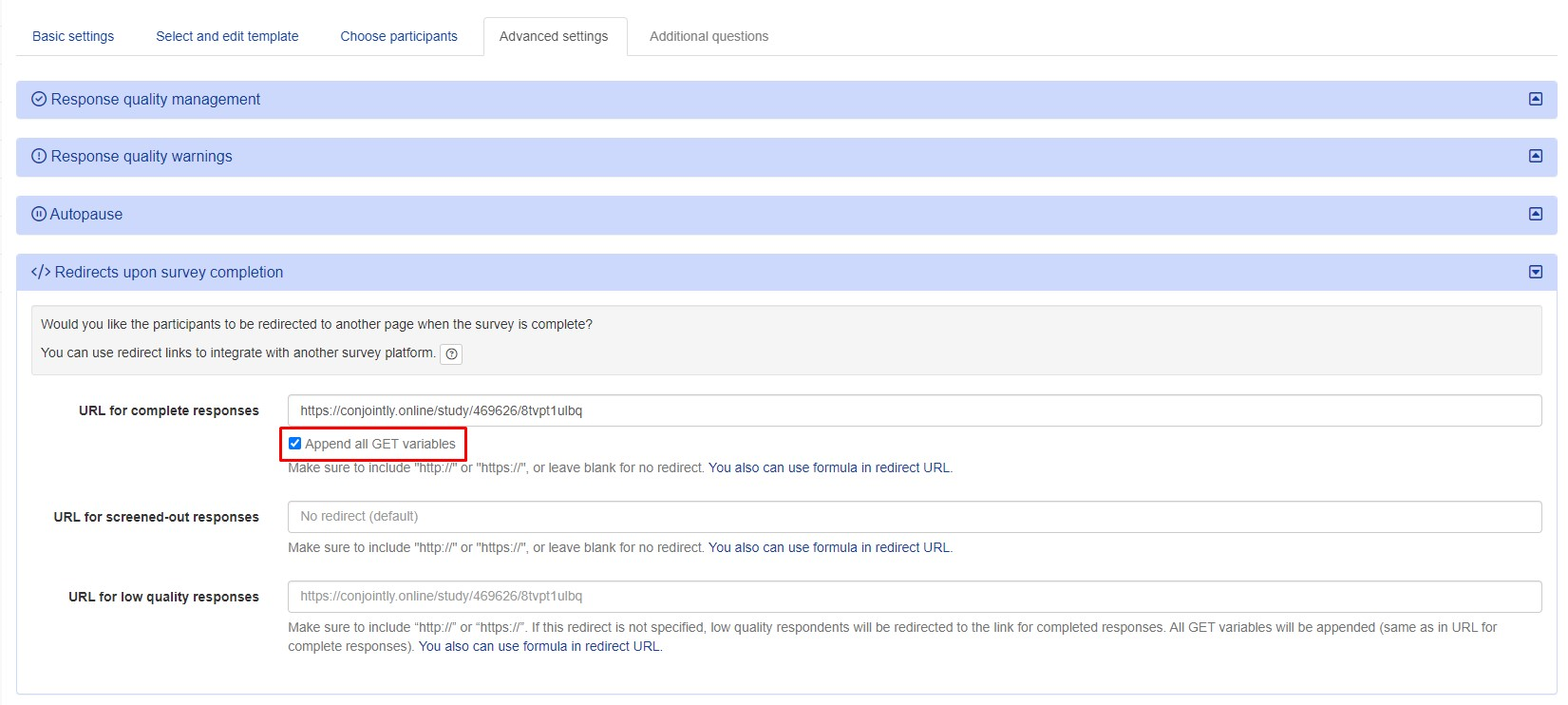
Redirect Option 2: Redirect for screen-out respondents at the end of survey
To redirect screen-out responses:
Go to the tab and go to the
Redirects upon survey completionsectionThere are three options of redirects, you will use the second option
URL for screened-out responsesby inputting the URL link that the screen-out respondents should be redirected to; You must have the complete link with thehttps://.
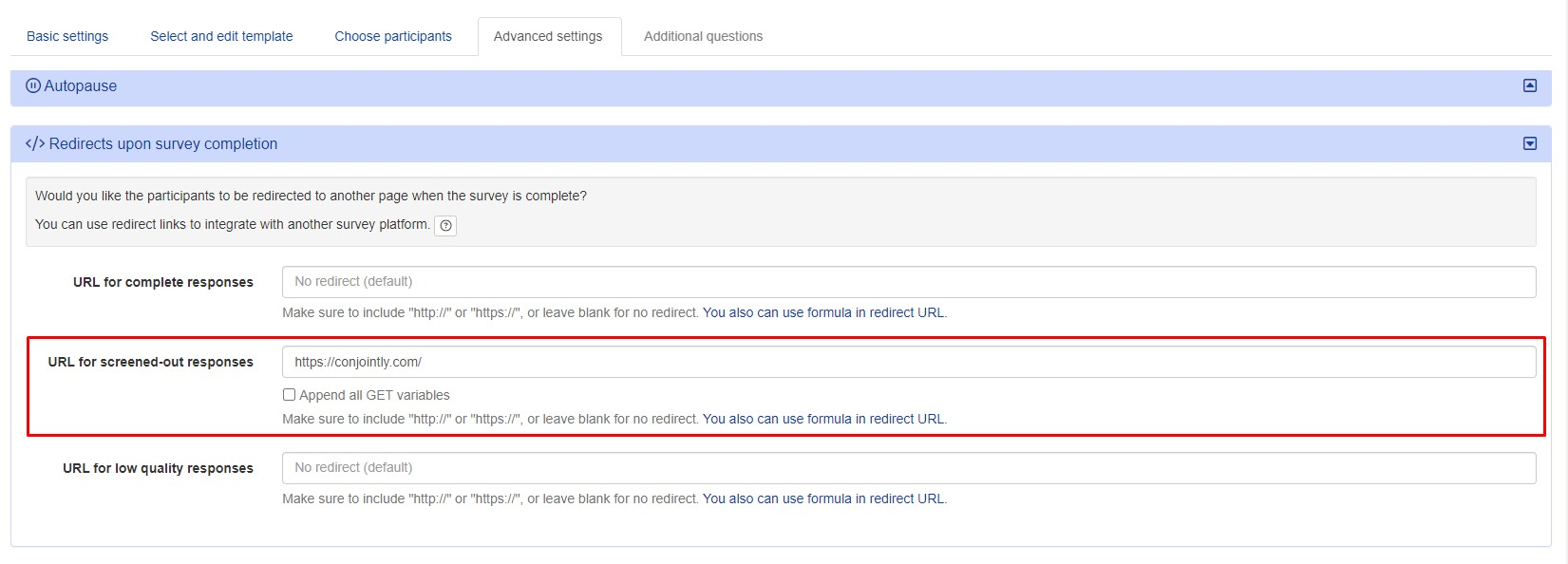
Redirect Option 3: Redirect respondents in the middle of survey if an option is selected
To redirect respondents if they select an option in a multiple-choice question:
Go to the Additional questions tab and select the question that has the option for redirects, e.g. a question asking about respondent’s gender
Select the nut button next to the question option, then select the action
Redirect (if option is chosen)

- The platform will ask you the redirect URL link. Similar to the other redirects methods, you should include the link with the
https://and append all the GET variables if you are including GET variables in the link to gather respondents’ information
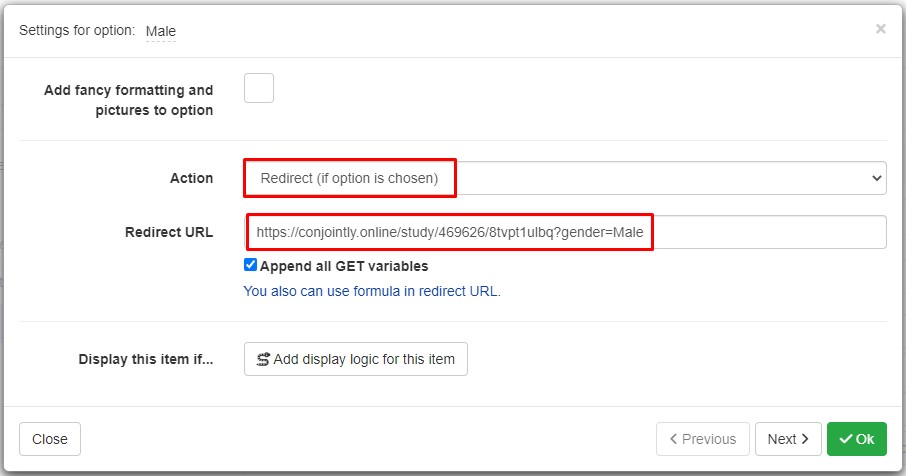
Redirect (if option is chosen), such as Redirect (if option is NOT chosen) for redirecting respondents if they do not select the particular option, as well as screening out respondents or marking them as low-quality if the option is chosen or not chosen.Redirect Option 4: Redirect respondents in the middle of survey if the quota is met
To redirect respondents if a quota is met:
Go to the Additional questions tab and select the question that you use to monitor quota, e.g. a question asking about respondent’s gender
Select the nut button next to the question option, then select the action
Redirect (if quota for answers is met)

- The platform will ask you the quota size and the redirect URL link. Similar to the other redirects methods, you should include the link with the
https://and append all the GET variables if you are including GET variables in the link to gather respondents’ information

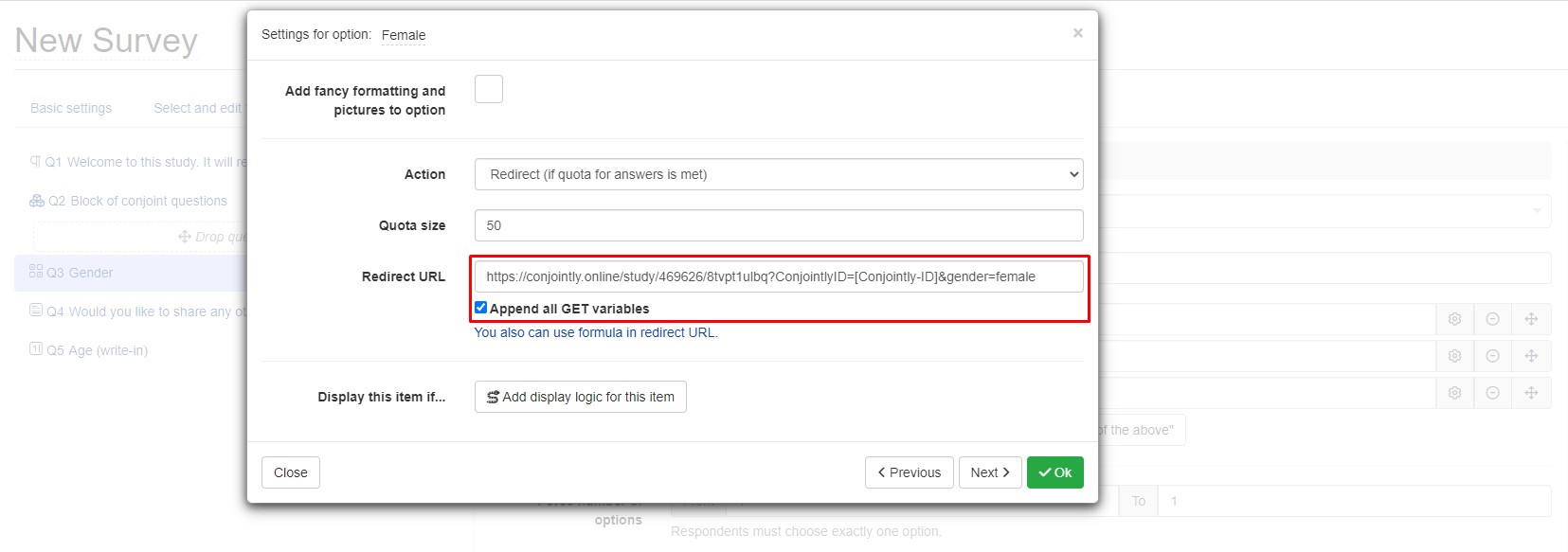
Redirect Option 5: Redirect respondents using survey flow controls
If you have a more complicated criteria to be met for redirects (e.g. select “Male” in Question 1 and age is between 18-29), you can utilise the survey flow controls. You can add them to your survey just like any other question, and you will have access to display logic to set up the criteria accordingly.
To set up a “Complete survey” flow control:
Go to the Additional questions tab and select at the bottom of the page
On the pop-up window, select Add a flow control or a block, then select
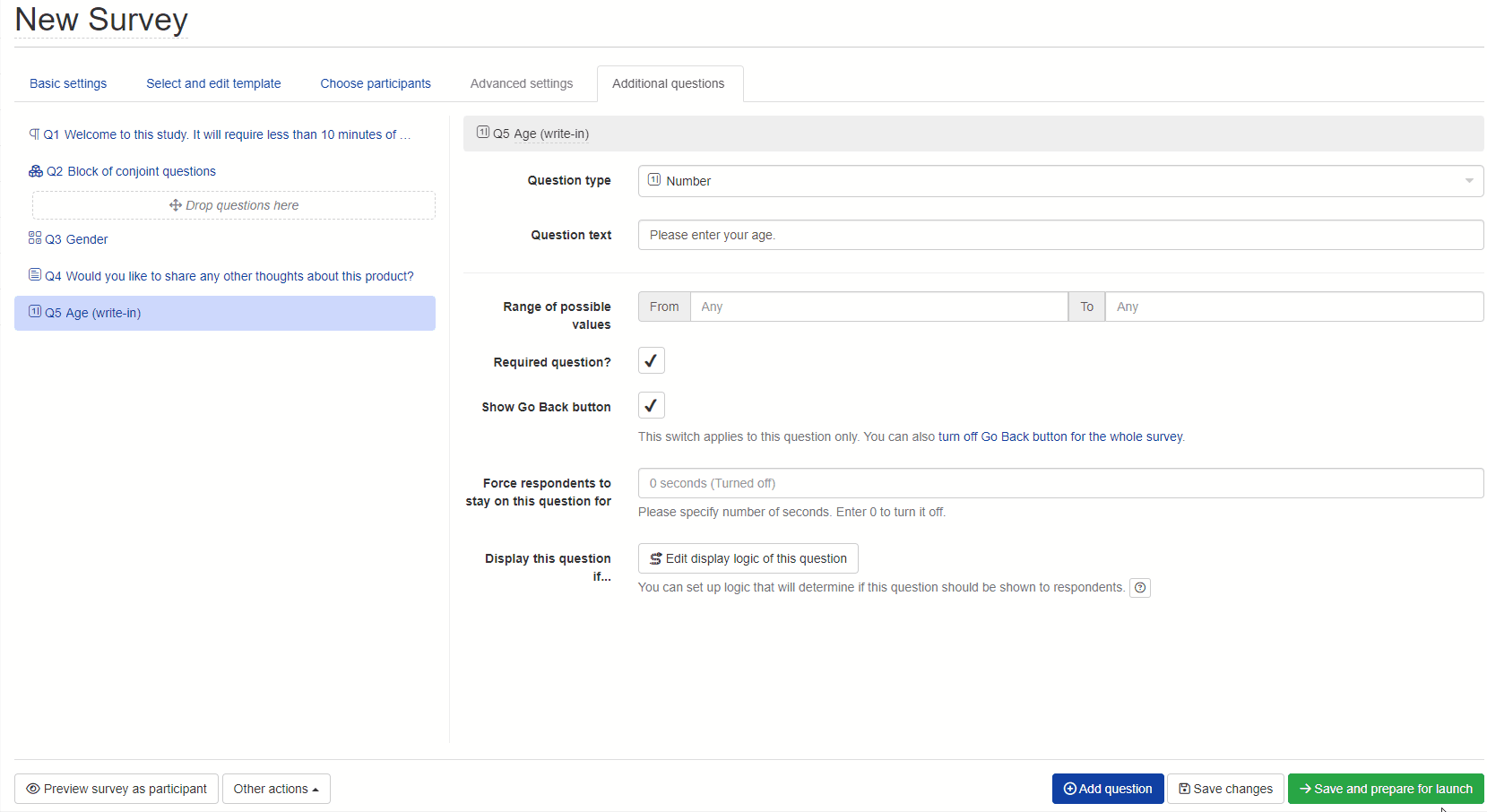
- You can then provide the custom redirect URL and specify the quota size accordingly. Similar to the other redirects methods, you should include the link with the
https://and append all the GET variables if you are including GET variables in the link to gather respondents’ information
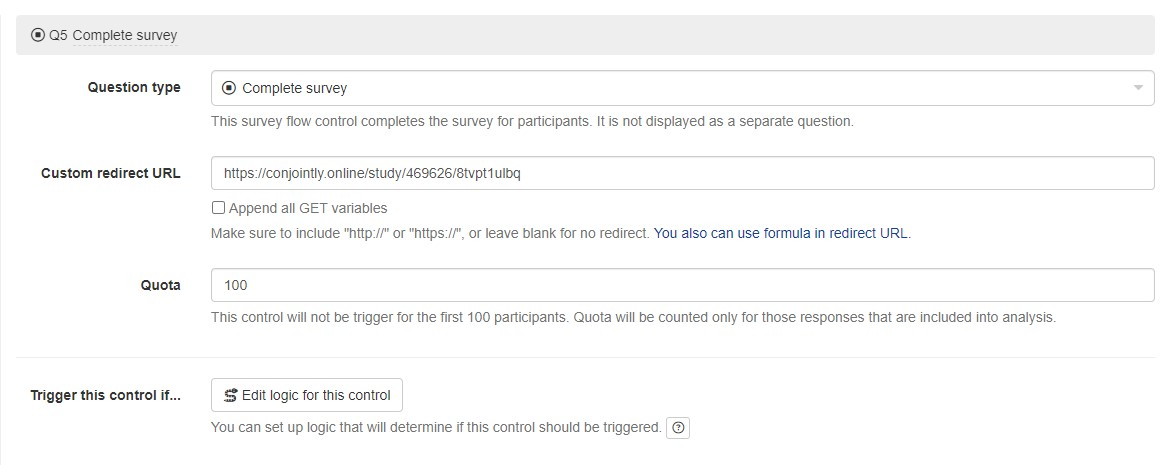
- Select the to set up the display rule to trigger this flow control. Then, select to start setting up the criteria you want to apply. For more information on display logic, please refer to the guide on conditional display logic.

How can I match participant IDs between two Conjointly experiments?
As demonstrated above, Conjointly allows for the combination of multiple experiments by creating each experiment separately and connecting them through redirects.
Nevertheless, each participant that is invited to complete a survey flow that consists of two or more different experiments will be assigned a unique Participant ID index for each individual experiment. Consequently, this makes the matching process between respondents relatively demanding as respondents appear to have a different identity in every single experiment of the whole survey flow.
In order to avoid this, you would add a GET variable with the value [Conjointly-ID] into the redirect URL of your next experiment (for example, https://conjointly.online/study/469626/8tvpt1ulbq?ConjointlyID=[Conjointly-ID]). By doing this, you will be able to pass the unique Participant ID index from the former experiment to the latter.
You can always find more information on how to work with Get variables.
How do I inform respondents that they will be redirected?
You can inform respondents that they will be redirected to another page for the second survey by changing the survey completion message:
Open the Select and edit template tab and select the
Page title and common textmodule.Enter your new survey completion message in the
Thank you message at the end of the surveyfield, e.g. “Please wait while you are being redirected to the second part of the survey.”.
Please note that the default message is “Thank you. Your responses have been saved”.

Example implementation of combining more than two experiments for one survey
Davids’ Co. is a consulting firm interested in finding the best claim for their company and understanding which subscription model is most profitable. The firm will run a Claims Test and a Generic Conjoint to get both insights at once. They are interested in analysing certain segments as well. As the screening questions will be asked in the Claims Test survey (Experiment 1), they want to be able to pass this information to the Generic Conjoint survey (Experiment 2). To do this, they will have to follow these steps:
On the Claims Test survey (Experiment 1), select the Advanced setting tab, and go to the
Redirects upon completionmodulePaste the shareable link of the Generic Conjoint survey (Experiment 2) in the
URL for complete responses formfield. At the end of the link, add a GET variable that passes on the participants ID from the Claims Test survey:https://conjointly.online/study/469626/8tvpt1ulbq?ConjointlyID=[Conjointly-ID]and tick theAppend all GET variablescheck box.

After data collection is completed, download the Excel report of the Claims Test experiment (experiment 1).
Delete the first two rows of the
Respondentssheet in the Excel export and save the sheet as a .csvClick the button in the Generic Conjoint (experiment 2) report.
Click and load the .csv file.
Select the GET variable (ConjointlyID) in the
Choose a variable to use for matchingoption, then select Participant ID in theChoose a column from the uploaded to match to the variableoption.Check the variables (columns) that you would like to upload (i.e. the data that you want to transfer from Experiment 1 to Experiment 2).
Reload the participants list.

- You can now create segments in the Generic Conjoint survey (Experiment 2) using the uploaded external variables from Claims Test survey (Experiment 1).